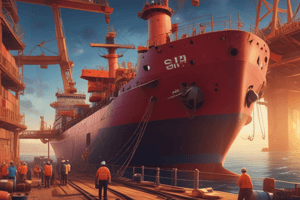Podcast
Questions and Answers
What is the primary aim of the International Convention on Load Lines (ICLL)?
What is the primary aim of the International Convention on Load Lines (ICLL)?
- To promote the use of freshwater routes
- To ensure the safety of passengers
- To prevent merchant ships from being overloaded (correct)
- To regulate the design of ships
What is the term for the distance between the waterline and the uppermost continuous deck of a ship?
What is the term for the distance between the waterline and the uppermost continuous deck of a ship?
- Load line
- Draft
- Height of the topsides
- Freeboard (correct)
Why does a ship feel heavier when it moves from saltwater to freshwater?
Why does a ship feel heavier when it moves from saltwater to freshwater?
- Because the ship's density is higher than that of freshwater
- Because the freshwater is less buoyant than saltwater (correct)
- Because the ship's design is not suitable for freshwater
- Because the ship is overloaded
What is the purpose of dividing the world into different geographical zones for load line regulations?
What is the purpose of dividing the world into different geographical zones for load line regulations?
What is a critical factor in determining the stability of a ship?
What is a critical factor in determining the stability of a ship?
What is the ultimate goal of load line regulations and calculations?
What is the ultimate goal of load line regulations and calculations?
What is the primary purpose of load lines on a vessel?
What is the primary purpose of load lines on a vessel?
What is the formula used to calculate the freshwater allowance?
What is the formula used to calculate the freshwater allowance?
What is the consequence of insufficient freeboard on a vessel?
What is the consequence of insufficient freeboard on a vessel?
What is the purpose of the load line certification?
What is the purpose of the load line certification?
What does the WNA mark on the load line certification indicate?
What does the WNA mark on the load line certification indicate?
Who has established a minimum freeboard requirement for its classed ships?
Who has established a minimum freeboard requirement for its classed ships?
Flashcards are hidden until you start studying
Study Notes
Load Lines and Freshwater Allowance
The topic of load lines and freshwater allowance is crucial for understanding the regulations and calculations that ensure the safety and stability of ships. This article will focus on the subtopics of load line regulations, freeboard calculation, freshwater allowance calculation, stability and stress considerations, and load line certification.
Load Line Regulations
Load line regulations are set by the International Convention on Load Lines (ICLL), which aims to prevent merchant ships from being overloaded and to ensure their structural integrity in various sea conditions. The ICLL divides the world into different geographical zones, each with a separate prescribed load line. For example, a vessel sailing in winter on the North Atlantic Ocean will have a greater freeboard than on a voyage in tropical zones and freshwaters.
Freeboard Calculation
The freeboard of a ship is the distance between the waterline and the uppermost continuous deck. It is an essential factor in determining the stability and safety of a ship. The calculation of freeboard involves considering the draft, the distance between the waterline and the uppermost continuous deck, and the height of the topsides.
Freshwater Allowance Calculation
When a ship moves from saltwater to freshwater, it feels heavier and sinks deeper into the water, increasing its draft. The freshwater allowance (FWA) is the millimeter by which the mean draft increases when the ship passes from saltwater to freshwater and vice versa. It is calculated using the formula FWA = W/(40*TPC), where W is the displacement of the ship in saltwater, expressed in tonnes, and TPC is the tonnes per centimeter immersion in saltwater.
Stability and Stress Considerations
Load lines play a crucial role in detecting whether a vessel is overloaded and its freeboard is sufficient. A vessel should have sufficient freeboard at all times, as insufficient stability and excessive stress on the ship's hull can lead to safety issues. Lloyd's Register has established a minimum freeboard requirement for its classed ships to ensure their good reserve buoyancy in heavy seas.
Load Line Certification
Load line certification is required for vessels to ensure they comply with the ICLL regulations. The certificate indicates the load line marks and the freshwater allowance, which are used to ensure the vessel's safety and stability in various sea conditions. The certificate is typically marked with lines such as S (summer), T (tropical), W (winter), WNA (winter North Atlantic), F (fresh water), and TF (tropical fresh water).
In conclusion, understanding load lines and freshwater allowance is essential for the safe operation of ships. These regulations and calculations ensure that vessels have the necessary freeboard and stability to navigate in different sea conditions.
Studying That Suits You
Use AI to generate personalized quizzes and flashcards to suit your learning preferences.




